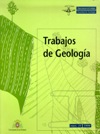Abstract
A Carboniferous succession 200 m thick, composed of limestone, marl, shale, sandstone and conglomerate, crops out some 1.400 m SE of Demués (Onís, Asturias). These strata are the most fossiliferous and continuous succession of synorogenic rocks currently known in the Picos de Europa Unit. Even though palynomorphs have been found at several levels, the fossil assemblages generally consist of many different benthic groups representing shallow marine environments. Brachiopods are the dominant group in these assemblages, which also include sponges, molluscs and crinoid remains. Foraminifers and ostracodes are the most abundant microfossils. Conodonts are very scarce. These palaeontological data allow us to correlate the Demués strata with other successions in the Picos de Europa Unit, as well as to date it in terms of both the West European and the Russian stratigraphic scales. The succession at Demués ranges in age from uppermost Moscovian or basal Kasimovian to the middle part of the Kasimovian (upper Khamovnicheskian) in the Russian stratigraphic scale, and probably from Cantabrian (lower?) to a level near the Barruelian /Estefanian B in the West European stratigraphic scale. As a consequence, the Demués section may provide some clues for the correlation between both scales in the upper part of the Carboniferous System.Downloads
Download data is not yet available.

